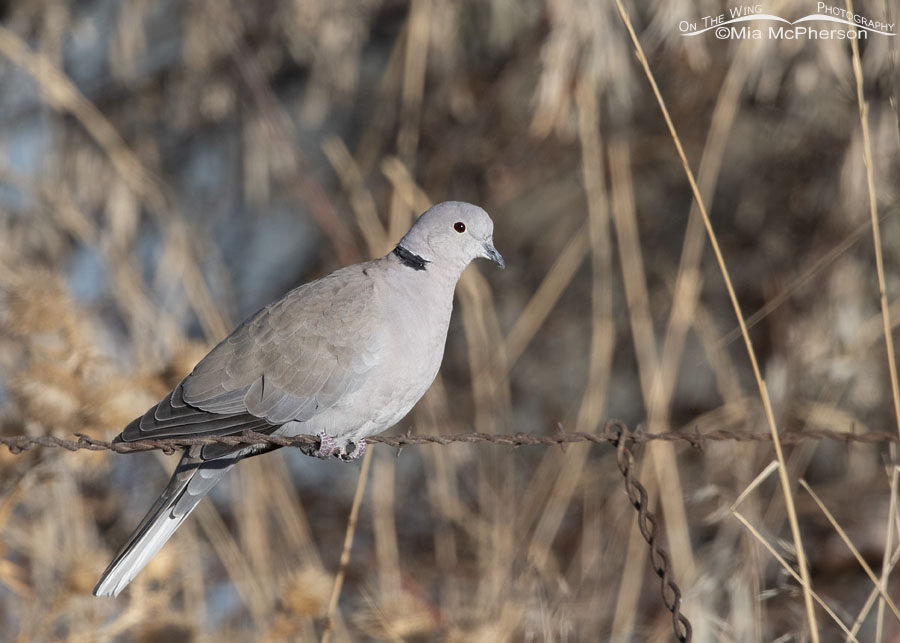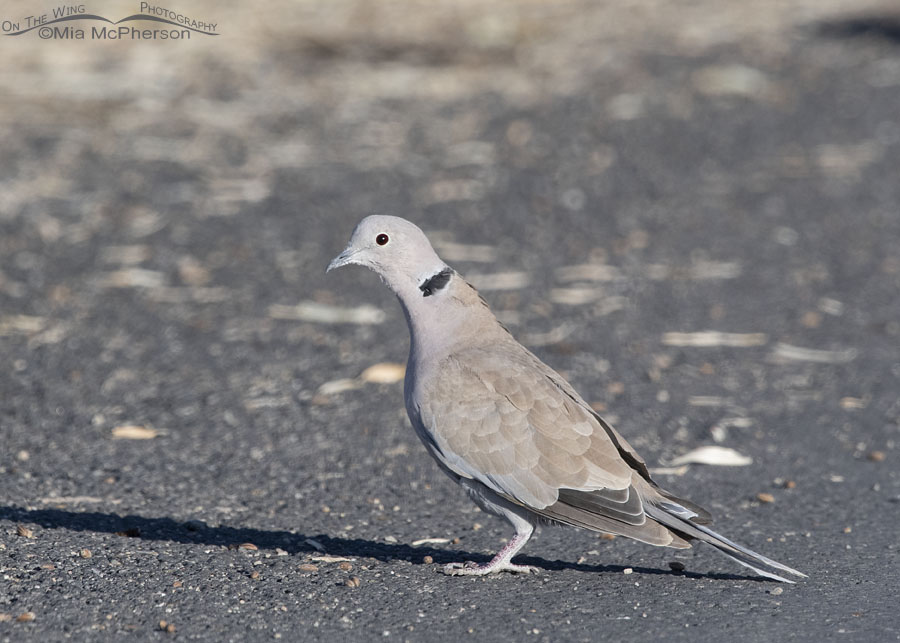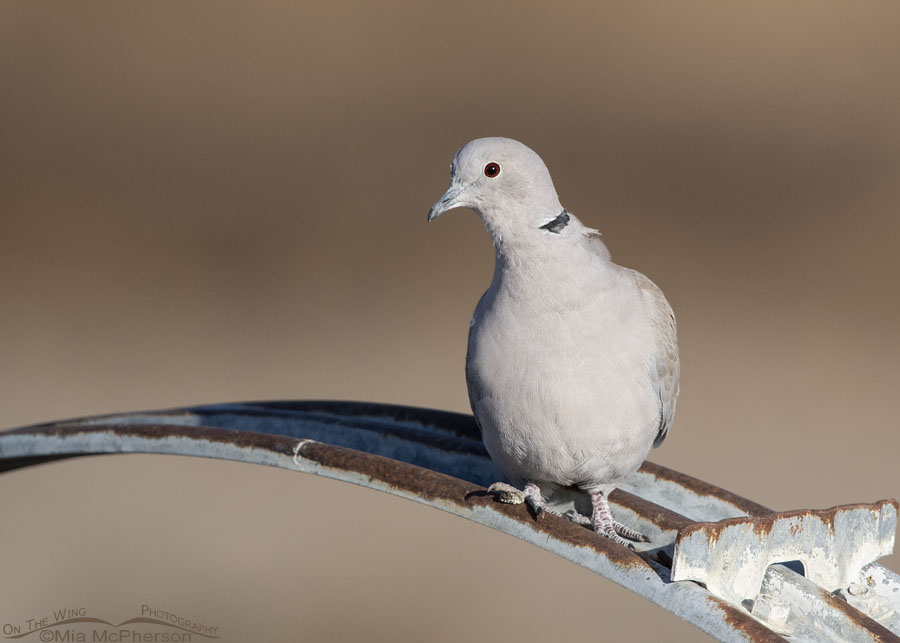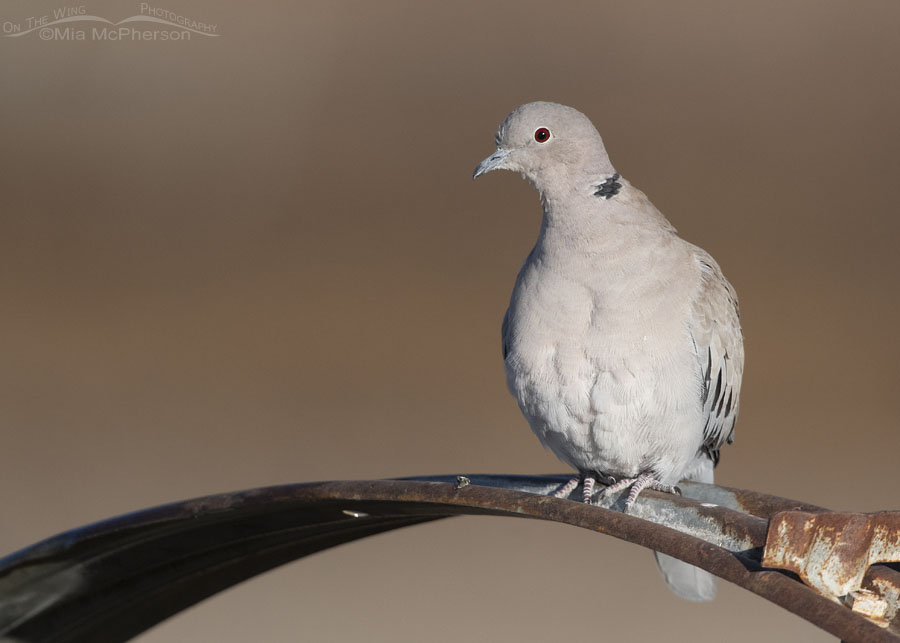 Eurasian Collared-Dove perched on a wire fence – Nikon D500, f8, 1/1600, ISO 640, Nikkor 500mm VR with 1.4x TC, natural light
Eurasian Collared-Dove perched on a wire fence – Nikon D500, f8, 1/1600, ISO 640, Nikkor 500mm VR with 1.4x TC, natural light
According to many sources Eurasian Collared-Doves reached Florida and the U.S. in the 1980’s from a few captive birds that were released in the Bahamas in the 1970’s and have spread rapidly since then. Now they can be found from the East Coast to the West Coast, as far south as Mexico and Central America and as far north as Canada and Alaska. They are also moving into areas of the Midwest and Northeast where earlier they hadn’t been reported.
When I first moved to Utah in 2009 I saw very few Eurasian Collared-Doves but now I see them in many locations and sometimes in large numbers.
 Eurasian Collared-Dove on pavement – Nikon D500, f8, 1/1250, ISO 640, Nikkor 500mm VR with 1.4x TC, natural light
Eurasian Collared-Dove on pavement – Nikon D500, f8, 1/1250, ISO 640, Nikkor 500mm VR with 1.4x TC, natural light
Usually I see Eurasian Collared-Doves in the cities, around farmer’s fields and open areas near towns. When I first moved to Utah I saw only a few Eurasian Collared-Doves near Farmington Bay and quite a few Mourning Doves. Now seeing Mourning Doves is unusual for me at that location but I am now seeing hundreds of the larger Eurasian Collared-Doves, especially near the pumpkin fields and Glover Pond. At home I see far more Eurasian Collared-Doves than I do Mourning Doves too.
 Alert Eurasian Collared-Dove on a water irrigation unit – Nikon D500, f6.3, 1/2500, ISO 640, Nikkor 500mm VR with 1.4x TC, natural light
Alert Eurasian Collared-Dove on a water irrigation unit – Nikon D500, f6.3, 1/2500, ISO 640, Nikkor 500mm VR with 1.4x TC, natural light
I personally don’t blame the Eurasian Collared-Doves for being here or for displacing or supplanting our native doves. Their presence here is directly related to humans.
 Eurasian Collared-Dove in morning light – Nikon D500, f6.3, 1/3200, ISO 640, Nikkor 500mm VR with 1.4x TC, natural light
Eurasian Collared-Dove in morning light – Nikon D500, f6.3, 1/3200, ISO 640, Nikkor 500mm VR with 1.4x TC, natural light
I still see our native Mourning Doves in Utah and usually I see them away from towns and cities, away from farmer’s fields and silos in the sagebrush covered hills, canyons and grasslands which is where I prefer to photograph them.
I’ll also photograph the Eurasian Collared-Doves when I have the chance because they are birds, the photographic subject I am most passionate about.
Life is good.
Mia
Click here to see more of my Eurasian Collared-Dove photos plus facts and information and information about this species.


Great pics of an immigrant dove. Before your post I had never heard of the Eurasian Collared dove. Your narrative was interesting and helpful. Thanks Mia.
They are an elegant looking bird, the grey feathers give them a sleek, velvety impression. Thank you for your photo and the accompanying information, which is much appreciated.
Mia, I never saw a Eurasian-Collared Dove until I moved from Utah to AZ in 2007. When I first moved there I think they had recently moved into the area. eBird was new then and AZ was not overly reported like it is now. In 2008 I reported a huge flock of these doves in Green Valley in the parking lot of the Green Valley Pecan Company. There were over 200 ECDOs there. My report was flagged as Rare due to the large numbers of birds seen. Now no one would blink an eye, I think. But I remember coming back to Utah in 2013 to visit my friend in Mountain Green and I was shocked to see this species in her yard. We have not yet seen one on the mainland in Maine, but they may have been reported on Monhegan Island. I wonder how long it will take before they infiltrate our area. I did not know they breed year round but I find it hard to believe they could raise young here in our harsh Northeast Winters. As a side note: This morning i had 22 Mourning doves in my yard. I personally love Mourning Doves. Your photos are lovely as always, and thanks for the information!
Thank you for showing a pigeon of any kind. You could fill a ball field with them if you tried.
When I looked at a bird map I noticed a lot of species are going further north in their migrations over the past few years. I was reading a report and 1/3 of the migrating birds in North America since the 70’s have declined due to human activity…CBC News reports ” some of the more common birds impacted include sea birds, backyard birds, warblers, finches, sparrows and songbirds, as well as long-distance birds like swallows and sandpipers that come to Canada from the Arctic”. I like your photos of the doves, never seen these ones before.
I still see more mourning doves than Eurasian in St George and nearby parts of Nevada. Eurasians breed year round where mourning doves do not, maybe that is why they are growing in numbers so quickly.
I haven’t seen any Eurasian Collared Doves in Niagara yet but like the House Sparrows and European Starlings they are taking over. No, you cannot blame the birds. It took humans to introduce them. They are a pretty bird though, I must say.